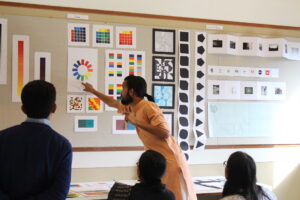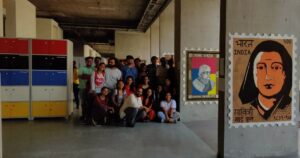


Communication Design is the art and practice of designing written and visual materials for a specific audience to transmit information, ideas, or messages. It encompasses a wide array of sub-disciplines under its umbrella and has evolved from graphic design, publication design, and brand development to include website design, film, animation, user interaction, and experience design. It entails the application of typography, graphics, images, colour, and other design elements to produce aesthetically appealing and efficient communication materials such as logos, ads, websites, posters, brochures and packaging, to name a few.
The BDes in Communication Design programme at the Institute of Design, Nirma University prepares students to become creative professionals in design. Through a combination of studio-based projects and theoretical coursework, students learn to develop visual communication solutions for various mediums, including print, digital, and experiential design.
Programme Duration: Semester 1-8 (4 years)
Foundation Year: Semester 1 – 2
Programme Specialisation: Semesters 3 – 8
Programme Duration: Institute of Design offers a BDes in Communication Design. The duration of the programme is four years which consists of eight semesters.
This 4-year undergraduate programme begins with a foundation year. There is an intense 15 weeks of learning each semester in studios, classrooms, workshops, and through fieldwork. Learning through apprenticeships and internships happens each year during the 10-week summer vacation. The 8th Semester is a 4-month long project which may be sponsored by industry, NGOs, or self-initiated by the student in response to an urgent societal concern.
Foundation Year: The foundation year spans Semester 1 and Semester 2 and is common to both BDes in Communication Design and BDes in Product and Interaction Design.
The two initial semesters are multi-disciplinary, immersive, and hands-on, preparing students to proceed to the specialisations of their choice. Students are introduced to the basic skills and sensibilities required to be a designer such as drawing, model-making, geometry, colour, elements of design, and the experience of working with varied materials. This is accompanied by environmental studies and an introduction to the design process, where students learn to interact with people and their habitats to learn to solve simple design problems. Course details from Semesters 1-2 are available here.
Programme Specialisation: After a common foundation of one year, students enter their area of specialisation. From the second year onwards, the focus shifts towards nurturing domain skills and knowledge as per the chosen programme.
The Communication Design programme structure at the Institute of Design is generic and all-inclusive at the undergraduate level. There are multiple courses offered to students for developing design skills, design theory, design concepts, and design projects.
The skills of visualisation are nurtured through engagement in photography, illustration, and typography modules. Reading and interpreting written and visual content is essential for a communication designer. This requirement is addressed by developing an understanding of semiotics, communication theories, and the study of visual narratives. The design for print and digital media starts with the understanding of printing and digital technologies that facilitate the realisation of concrete outputs in identity design, branding, publication design, and the design of websites or digital applications. Each module is embedded in an intense design process. Inputs in system thinking, way-finding systems, 3-D visualisations and space design lead to the holistic development of the students. Course details from Semesters 1-8 are available here.
In the third year of study, from Semester 5, the students are offered two pathways and select a minor specialisation through the electives route. The two pathways are Graphics and UI-UX Design and Moving Image – Animation and Film Design.
The programme is industry-focused and interspersed with internships that give many opportunities for engagement and interaction with industry experts. The programme has multiple apprenticeship/internship opportunities:
The Communication Design students thus, trained in the analogue and digital mediums are prepared to leave their design footprints to make a difference in the world. The students work as creative team members in design studios, advertising companies, and branding consultancy services. They take on the entrepreneurial journey to offer design services to industries with specialised requirements.
Placements are a part of the academic responsibility of the institute. The students of communication design have been paving a path of excellence and are being placed in companies of repute.